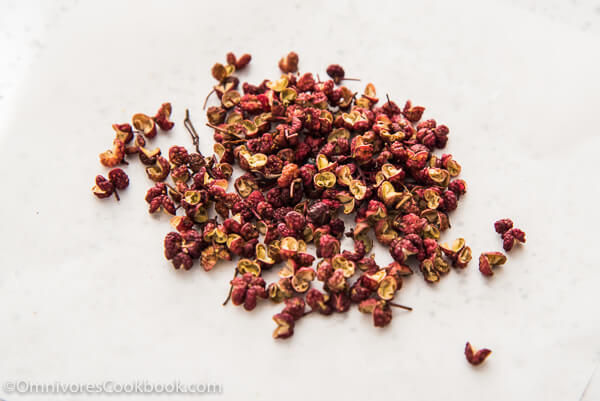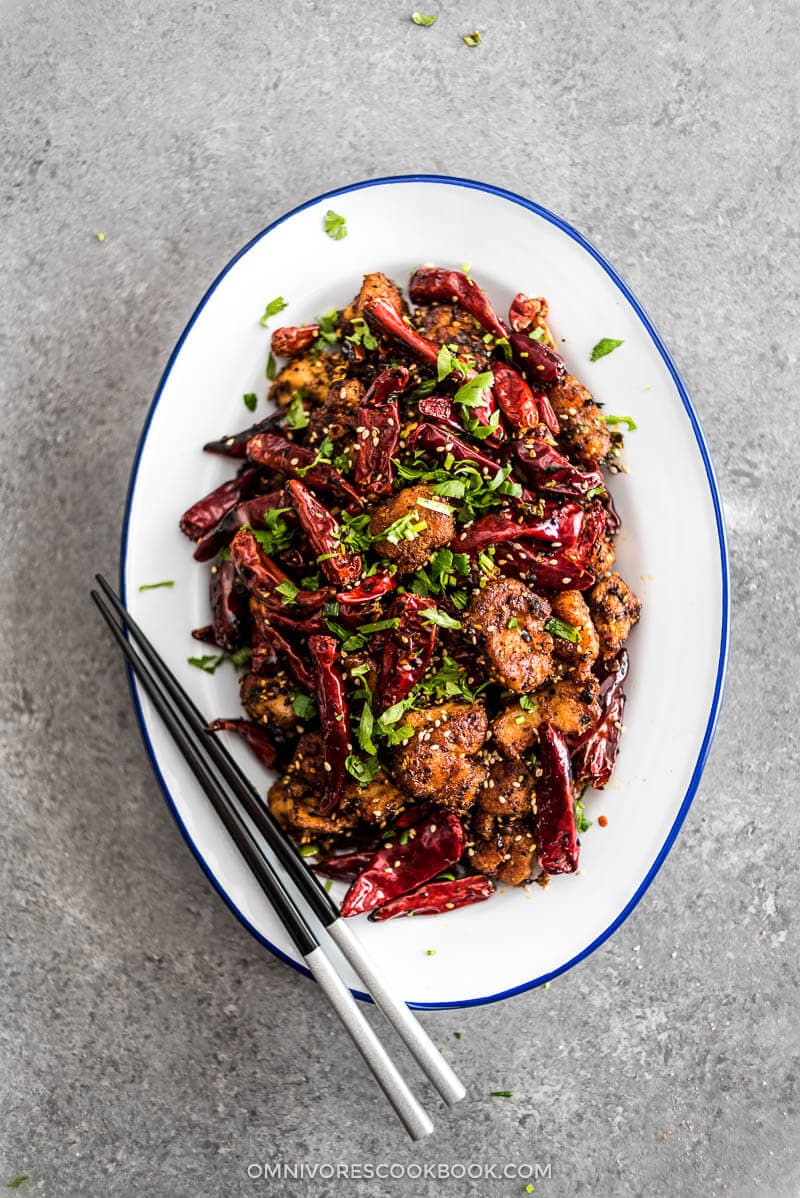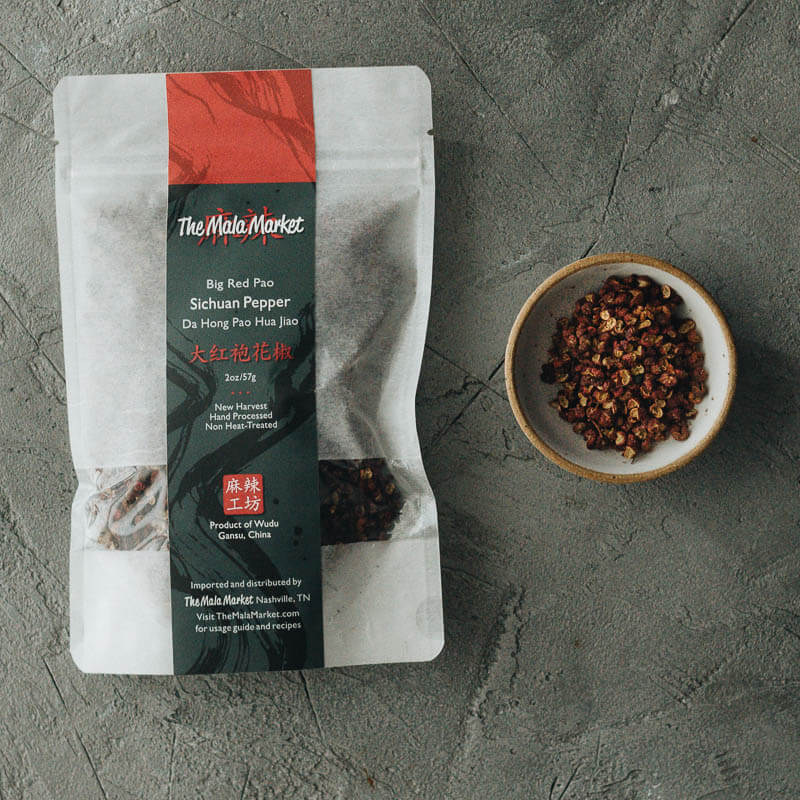Sichuan peppercorn (花椒, Huā Jiāo) is also known as Szechuan pepper. It is so fundamental to the region’s cuisine that it is often known as ‘chuān jiāo’ (川椒), coupling the name of the province to its magical spice. Its unique aroma and flavor are not hot or pungent like typical black, white, or chili peppers. In fact, you can’t really call it spicy. Instead, it has slight lemony overtones and creates a tingly numbness in the mouth – which can almost be described as electric – that sets the stage for hot spices.

Understand
Huā Jiāo (literally ‘flower pepper’ because of its shape) has an appearance and size similar to that of black pepper, but with a split-open browny-red husk.
First, the pink-red berries are harvested from a prickly ash shrub grown in the rural areas of China’s southwestern province. Once dried and the seed removed, the peppercorn can be used whole or ground as a versatile ingredient in many specialty dishes or combined with other spices.
On a recent Chengdu street food adventure with Jordan from Chengdu Food Tours, I learnt just how essential this ingredient is in so many typical southwestern Chinese dishes.
Sichuan peppercorn has a pungent aroma, slightly lemony overtones, and numbing properties. If you bite into one of these small peppercorns, you’ll immediately feel the tongue-tingling, buzzing, party-in-your-mouth sensation otherwise known as ‘málà’ – numbing spice.
Use
Depending on whether it is kept whole, chopped or ground up after being dried, Sichuan peppercorn can be put to a myriad of different uses. Given its sharp flavor, it is often used to infuse oils with its málà essence, blended into the recipe of numerous sauces such as Spicy Fermented Bean Paste, incorporated into stir fries, salads, stews, soups and braised dishes. Ground peppercorn powder is also found in Chinese Five Spice Powder. Classic Sichuan and Chongqing hotpots will also use the whole peppercorn in large quantities and sometimes still on the branch, so you have to be careful not to bite into a bunch of husks while eating!
It is very difficult to source high-quality Sichuan peppercorn outside of China, and the fresh ones make a really big difference when it comes to cooking. Luckily, Taylor from The Mala Market sources it from Hanyuan County, whose red huā jiāo is the most sought-after in the world, for the most fresh-off-the-shrub intense mouth buzz.
Basic cooking method
In pretty much all recipes you could cook the peppercorn in one of two main ways.
- Cook whole Sichuan peppercorns in a bit of oil until they have turned brown, drain the oil, then grind the Sichuan peppercorns. Grinding eliminates the raw numbing zing and gives it a more rounded aroma. The peppers will be less potent so you can use more to add fragrance. The roasted and ground peppercorns work well in stir fried and cold dishes.
- Whole Sichuan peppercorns can be directly added to a braised dish, especially one involving pork, duck or lamb. Besides adding umami to the dish, the peppercorn has another function – it removes the game flavors that some meats may release.
Although an authentic Chinese meal will contain whole peppercorns in various dishes when served, you can remove them so your guests won’t accidentally bite into them.
Classic Sichuan recipes using Sichuan peppercorns
Many world-famous Chinese dishes uses Sichuan peppercorn as an essential ingredient. It can’t really be compared with or substituted by any other ingredient. If you’re keen to replicate traditional Sichuan food, try it out in the following dishes!
- Chili Oil – It only takes five minutes to make the best-tasting málà chili oil with extra fragrance, nuttiness and smokiness
- Sichuan Dry-Fried Green Beans – These fresh green beans are slowly roasted until blistered and beautifully charred, then tossed with spices
- Fu Qi Fei Pian – Southwestern China’s biggest foodie secret, this sliced beef with chili sauce is for hardcore Sichuan cuisine enthusiasts
- Kung Pao Chicken – Authentic Kung Pao Chicken uses the freshest Sichuan peppercorns to make it like nothing you’ve ever had
- Mapo Tofu – The most famous of all Sichuanese dishes, Mapo Tofu would be nothing without huā jiāo!
- Mala Chicken – A plate of crispy chicken smothered in chili peppers: only take the challenge if you can handle the heat!
- Dan Dan Noodles – A modern recipe that stays true to Sichuan flavour, with the option to adjust the spice levels for a good balance of heat.

Other recipes using Sichuan peppercorns
Sichuan peppercorn has exploded in popularity across mainland China and can now be found in all kinds of regional cuisine. Here are some non-Sichuanese dishes that have used the magical properties of the peppercorn to add a new flavor profile:
- Grilled Lamb Skewers – Despite being over a thousand miles away, the province of Xinjiang has taken Sichuan’s famous peppercorn and incorporated into their most beloved BBQ lamb
- Chinese Beef Pie – Huā jiāo travels to the north of China in this hearty beef pie with a crispy crust and a juicy filling
- Crispy Spicy Salmon – The savory, simple and straightforward spicy seasoning goes perfectly with the creamy mustard yogurt sauce atop this salmon
- Xinjiang Cumin Lamb – Using spices instead of sauce, the lamb comes out like a flavor bomb that explodes in your mouth
- Fried Cabbage – Pepper-infused oil adds fragrance and a numbing spicy hint to the sweet cabbage
- Sesame Noodles – The secret ingredients in this recipe are chili oil and roasted peppercorn powder, truly wowing your guests.
Buy
Interestingly, the import of Sichuan peppercorn was actually banned from the US for almost 40 years. The ban has since been lifted, but still much of what you find in Asian supermarkets is the product after a short heating process which drastically diminishes its quality.
The Mala Market, who I mentioned earlier and whose website explains the production process here, carries premium Sichuan peppercorns that are very fresh and potent, which is super rare for this ingredient. They are the best Sichuan peppercorns I’ve found in the US so far and I highly recommend 😊
Store
After purchasing, keep whole Sichuan peppercorn in a sealed jar away from light or in the fridge. After a few months it will start to lose its potency, so any surplus that you want to keep long-term should either be infused in a cooking oil or be stored in the freezer as fresh as possible. Ground peppercorn loses its taste much more quickly, so should be used within a few weeks.














Hi, Maggie,
Do you have to get a good quality Sichuan peppercorn? What brand of peppercorn do you use for the Sichuan garlic chili sauce?
Hi Susan, yes, the good quality Sichuan peppercorns do make a huge difference in cooking. Unfortunately, the Sichuan peppercorns in the US need to be heated up to 158 °F to kill citrus canker before import, in a result that they’ll lose the numbing flavor. So it’s nearly impossible to replicate the real Sichuan flavor, unless you purchase Sichuan peppercorns in China (or Asia). I brought back a big bag of Sichuan peppercorns every time I visited China, so I have a good stock to use in my dishes.
There is a good Chinese brand “Chuan Zhi Wei” that you can get in most Asian markets in the US. If you cannot locate it, you can order it online too: http://www.posharpstore.com/en/chuanzhiwei-sichuan-red-peppercorns-prickly-ash-317-oz
For the Sichuan peppercorns, you can’t really tell the quality until you smell it. Because they’ll lose flavor when they’re on the shelf too long time (which is usually the case here, because the turnover is low). It should have a pungent numbing spicy fragrant when fresh, instead of stale and chemical smell. If you get a chance to purchase them in a spice shop where you can smell them first, it’ll also be a great way to go.